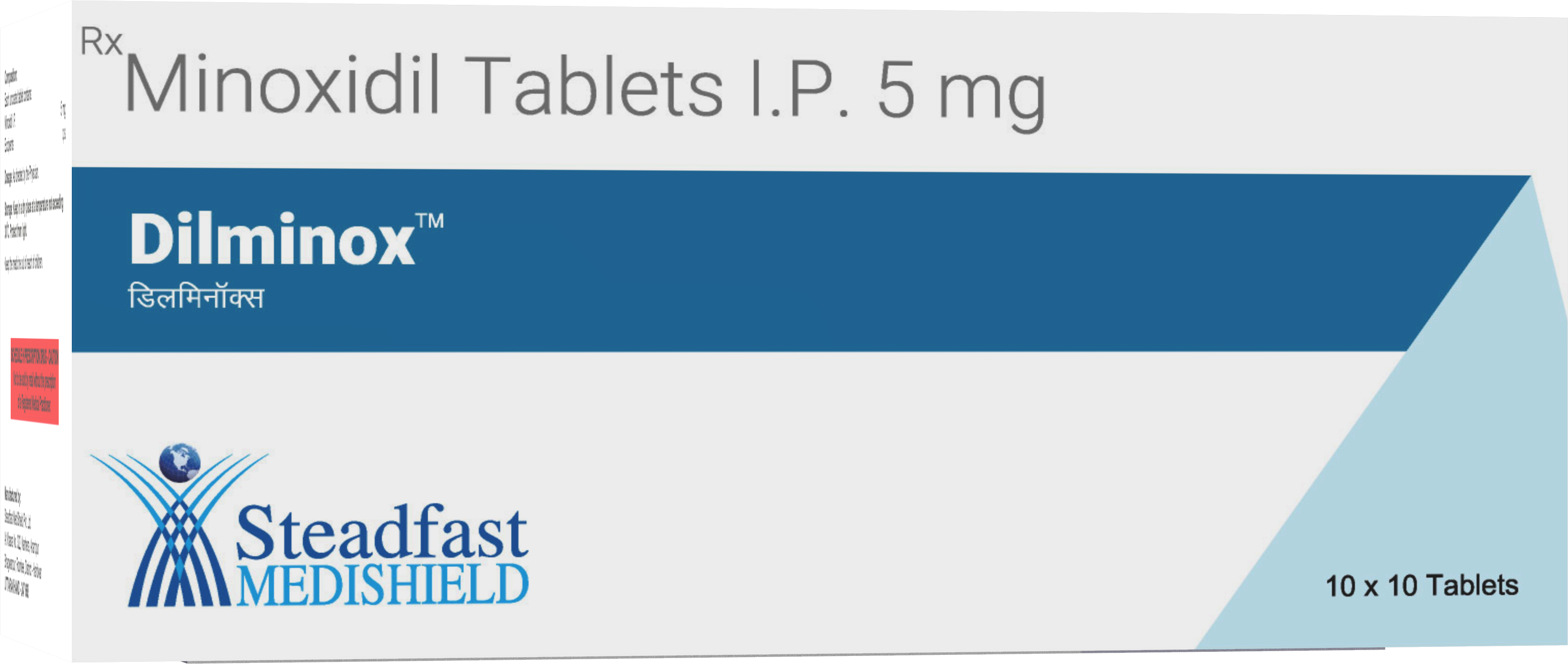
Description
Minoxidil (Dilminox) is an orally active peripheral vasodilator. The pure compound is soluble in water to the extent of approximately 2 mg/ml and is readily soluble in propylene glycol or ethanol. Chemically, Minoxidil (Dilminox) is 2.4-diamino-6-piperidino-pyrimidine-3-oxide. The Molecular Weight is 209.25.
Composition
Each uncoated tablet of Dilminox contains Minoxidil I.P. 5 mg
Pharmacology
Minoxidil (Dilminox) selectively relaxes the arteriolar smooth muscle, which reduces peripheral vascular resistance and lowers systemic blood pressure. This is accomplished without a diminution of nutritional flow to body tissues or interference with normal vasomotor reflexes.
Minoxidil (Dilminox) does not directly stimulate the heart or electrolyte reabsorption of the kidney. However, Minoxidil’s (Dilminox) administration elicits a reflex mediated increase in cardiac output, salt and water retention, and a rise in plasma renin activity. These effects are diminished by the simultaneous administration of diuretics and beta-adrenergic blocking agents.
Gastrointestinal absorption is rapid and amounts to at least 95% of the administered dose. Serum levels of the parent drug peak within the first hour. The plasma elimination half-life of Minoxidil (Dilminox) is approximately 4-4.5 hours, but the duration of its hypotensive action may exceed 24 hours. This disparity between blood level and pharmacological effect and the large volume of distribution indicated extensive tissue localization of the drug. However, on chronic treatment, accumulation does not occur and the pharmacological effect is slowly reversible.
With an effective oral dose, blood pressure usually starts to decline within one — half hour, reaches a minimum between 2 and 3 hours and recovers at a rate of approximately 30%/day.
During daily administration, there is a cumulative effect which reaches a steady state after 3 to 7 days. The magnitude of the blood pressure response is related to the extent of the original diastolic elevation above 85 mm Hg and is proportional to the logarithmic function of the dose administered. When the desired diastolic reduction is greater than 30 mm Hg, twice a day dosing is advised to keep the diurnal variation within 10 mm Hg.
Minoxidil does not bind to plasma proteins, enter the central nervous system or accumulate in body tissues. Metabolism is predominantly by glucuronic acid conjugation. Metabolites are excreted principally in the urine and can be removed by hemodialysis in anephric patients. Hemodialysis does not, however, rapidly reverse the pharmacological effect of Minoxidil.
Indications
It is indicated as adjunctive therapy in adults with severe refractory hypertension, which has failed to respond to extensive multiple therapies. When used in combination with an accompanying diuretic and beta-blocker, Minoxidil (Dilminox) has been shown to reverse encephalopathy and retinopathy in severe hypertensives.
Contraindications
Minoxidil (Dilminox) is contraindicated in phaeochromocytoma and pulmonary hypertension secondary to mitral stenosis.
Warnings
If used alone, Minoxidil (Dilminox) can cause a significant retention of salt and water, producing dependent oedema, puffiness of face, eyes or hands, neck vein distention and hepatojugular reflux. Chest X-rays may show evidence of pulmonary vascular engagement. The clinical condition of some patients with symptomatic heart failure may deteriorate under these circumstances. Diuretic treatment alone or in combination with restricted salt intake will minimize this response.
Refractoriness to these measures may require temporary discontinuation of Minoxidil (Dilminox) therapy for 1 or 2 days, during which there may be partial loss of blood pressure control.
Angina pectoris may develop in patients with unsuspected coronary artery disease, unless protected against Minoxidil (Dilminox) induced tachycardia with beta-adrenergic blocking drugs or other suitable sympathetic nervous system suppressants. Patients with unstable angina pectoris or angina pectoris of recent onset should be protected with these agents before starting Minoxidil (Dilminox) therapy.
The blood pressure lowering effect of Minoxidil (Dilminox) is additive to concurrent antihypertensive agents. The interaction of Minoxidil (Dilminox) with agents that produce orthostatic hypotension may result in excessive blood pressure reduction. In patients with pulmonary hypertension associated with mitral valve regurgitation, caution is necessary to avoid excessive tachycardia.
Precautions
Minoxidil (Dilminox) is not recommended for the treatment of patients with labile or mild hypertension.
Minoxidil (Dilminox) should not be used for extended therapy in hypertension readily ameliorated by surgery, e.g., Coarctation of the aorta, primary aldosteronism or unilateral, large vessel renal artery stenosis.
Salt and water retention in excess of 2 to 2.5 kg of weight gain may diminish the effectiveness of Minoxidil (Dilminox). Therefore, patients should be carefully instructed about compliance to diuretic usage and limitation of their sodium intake.
Elongation, thickening and enhanced pigmentation of fine body hair (Hypertrichosis) un-associated with endocrine abnormalities, is seen in most patients. It is usually first noticed in the facial area 3 to 6 weeks after starting therapy and may recede slightly during prolonged therapy and is reversed 1 to 3 months after Minoxidil (Dilminox) is discontinued.
All patients should be fully informed of this possible effect before commencing Minoxidil (Dilminox) therapy.
Right atrial lesions have been found in dogs treated with Minoxidil at dosages as low as 0.5 mg/kg/d. Similar lesions have been produced with the 4-hydroxy metabolite (20 mg/kg/d) in the beagle dog. However, studies in other species with either Minoxidil or the 4-hydroxy metabolite have not produced these changes.
In addition, hemorrhagic lesions of the coronary arteries were observed mainly in the right atrium of dogs (and the left atrium of mini-pigs).
In dogs, mini-pigs, rats and hamsters necrosis of the papillary muscles and, in some cases, sub-endocardial areas of the left ventricle were observed following a few days treatment. Beta adrenergic receptor blockade reduced the incidence and severity of the alterations.
There was no evidence in 78 autopsied patients that similar lesions have occurred in humans receiving Minoxidil (Dilminox). However, studies till date cannot exclude the possibility of such lesions occurring in man.
Approximately 60% of patients exhibit ECG alterations in the direction and magnitude of their T-waves soon after starting Minoxidil (Dilminox) therapy. Large changes may encroach on the ST segment, but the ST segment is not independently altered and there is no evidence of myocardial ischemia. These asymptomatic changes usually disappear with continuing Minoxidil (Dilminox) treatment. The ECG reverts to the pretreatment state if Minoxidil (Dilminox) is discontinued.
Pericardial effusion has been detected in 3% to 4% of patients treated with a Minoxidil (Dilminox) containing regimen. In more than one-half of these cases, the effusion had been evident pretrial or occurred among chronic dialysis patients. Most of the effusions in non-dialysis patients were attributed to factors such as uremia, massive volume overload, congestive heart failure and open A-V shunt, or an infectious, autoimmune or connective tissue disease. Minoxidil (Dilminox) treated patients should be periodically monitored for signs or symptoms of these events and, if found, appropriate therapy should be instituted.
Patients who have had a myocardial infarction should be only treated with Minoxidil (Dilminox) after a stable post-infarction state has been established.
Use in Pregnancy
Minoxidil (Dilminox) has been associated with hypertrichosis in the newborn infant following exposure in utero.
Use in Lactation
It is not known whether Minoxidil (Dilminox) is excreted in breast milk, or whether it has a harmful effect on the newborn. Therefore, it is not recommended for nursing mothers unless the expected benefits outweigh any potential risk.
Side Effects and Adverse Reactions
Most patients receiving Minoxidil (Dilminox) have experienced a diminution of pre-existing adverse medical events attributable to their disease or previous therapy. New events or events likely to increase include: Peripheral oedema associated with or independent of weight gain, increases in heart rate, hypertrichosis, a temporary decline in hemoglobin and haematocrit, a temporary rise in creatinine and BUN.
Infrequently reported side effects include hypotension, gastrointestinal intolerance, rash and breast tenderness.
Dosage and Administration
The usual adult dosage range of Minoxidil (Dilminox) is 5-40 mg/day. The maximum recommended dosage is 100 mg/day.
Minoxidil (Dilminox) therapy can be initiated with a single or divided daily dosage. If the desired reduction in diastolic pressure is greater than 30 mm Hg, divided dosage will minimize diurnal fluctuations. Dosage adjustments should be made at intervals of 3 days or longer.
A more rapid reduction of pressure can be achieved using continuous blood pressure monitoring and incremental doses of 5 mg every 6 hours.
Dosage requirements may be lower in patients undergoing chronic dialysis.
Prior to introducing Minoxidil (Dilminox), it is recommended that the anti-hypertensive therapy be adjusted to a regimen consisting of a diuretic and a beta-adrenergic blocking agent. When other sympathetic nervous system suppressants are used, the initial dosage of Minoxidil (Dilminox) should be reduced.
Patients over 12 years of age
Initial Dosage: 5 mg as a single daily dosage.
Incremental Increases: 5-10 mg/day at 3 day intervals, until 50 mg/day is reached; then in increments of 25 mg/day up to a maximum of 100 mg/day.
Concomitant Therapy
Diuretics
Minoxidil (Dilminox) must be given with sufficient diuretic therapy to maintain salt and water balance in all patients who are not on dialysis. When excessive water retention results in a weight gain exceeding 2.0 – 2.5 kg while on a thiazide or chlorthalidone, a more potent diuretic, e.g., frusemide, should be used.
Sympathetic Nervous System Suppressants
Initially, most patients will require a sympathetic nervous system suppressant to limit a Minoxidil (Dilminox) induced rise in heart rate. The preferred agent is a beta-blocker equivalent to an adult propranolol dosage of 80-160 mg/day. Higher doses may be required when pretreated patients have an increase in heart rate exceeding 20 beats/minute, or when simultaneous introduction causes an increase exceeding 10 beats/minute. When beta-blockers are contraindicated, methyldopa or clonidine may be used instead and should be started 24 hours prior to Minoxidil (Dilminox).
Overdosage
Hypotension resulting from the administration of Minoxidil (Dilminox) has occurred on only a few occasions. When exaggerated hypotension is encountered, it is most likely to occur when Minoxidil (Dilminox) is used in association with antihypertensive agents that block sympathetic nervous system responses (guanethidine-like effects of alpha-adrenergic blockage) and compensatory mechanisms. Sinus tachycardia has also been reported.
Due to patient-to-patient variation in blood levels, it is difficult to establish an overdosage warning level. In general, a substantial increase above 2000 ng/mL should be regarded as overdosage, unless the physician is aware that the patient has taken no more than the maximum dose. Treatment is primarily symptomatic and supportive. Consider administration of activated charcoal in the event of a potentially toxic ingestion. Activated charcoal is most effective when administered within 1 hour of ingestion. In patients who are not fully conscious or have impaired gag reflex, consideration should be given to administering activated charcoal via nasogastric tube once the airway is protected. Recommended treatment for hypotension is intravenous administration of normal saline. Sympathomimetic drugs, such as noradrenaline, should be avoided because of their excessive cardiac-stimulating action. Phenylephrine, angiotensin II and vasopressin, which reverse the effect of Minoxidil (Dilminox), should be used only if inadequate perfusion of a vital organ is evident.
Presentation
10 tablets packed in a strip, 10 such strips packed in a carton
